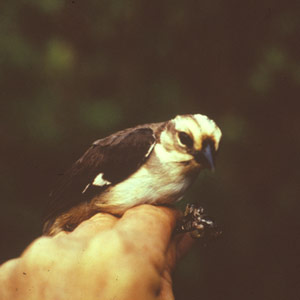Magazine | Études
L’Atlapetes à tête blanche n’a pas disparu !

Atlapetes à tête blanche (Atlapetes pallidiceps)Photographie : NBII Image Gallery / Wikimedia Commons
Introduction
L’Atlapetes à tête blanche (Atlapetes pallidiceps) est un passereau endémique du bassin du Rio Jubones (Équateur), où il avait été noté pour la dernière fois en 1969. Sa biologie était méconnue. Du fait de l’échec de plusieurs expéditions menées pour essayer de l’observer, l’espèce a été considérée comme probablement éteinte par Collar, qui avait rassemblé toutes les données disponibles sur l’oiseau. Lors d’une expédition de la CECIA (société ornithologique de l’Équateur) menée du 10 au 24 novembre 1998, Ana Agreda, Niels Krabbe et Orfa Rodriguez ont redécouvert une petite population à 1 650 – 1 800 mètres d’altitude dans la vallée de Yunguilla, dans la région d’Azuay. Quatre couples ont été notés, et l’étendue de l’habitat favorable pourrait au moins en accueillir le double. Lors d’une seconde visite dans la zone les 3 et 4 décembre 1998, Niels Krabbe et Francisco Sornoza ont localisé un couple dans une hacienda à 1 km, pouvant abriter au maximum cinq couples. De un à deux couples ont été recensés. L’espèce a été trouvée dans une zone aride parsemée de buissons, un habitat menacé par la mise en culture partout dans le bassin du Río Jubones.
Abstract
The Pale-headed Brush-finch Atlapetes pallidiceps is endemic to the Río Jubones drainage in southern Ecuador, where it was last recorded in 1969. Its habitat preferences were unknown. Because several recent attempts by skilled observers to locate it had failed, the species was considered possibly extinct by Collar et al., who summarised all available information on the species. On a CECIA (Ecuador’s ornithological society) expedition in search of the species on 10-24 November 1998, the authors rediscovered a tiny population at 1,650-1,800 m elevation in the Yunguilla Valley in Azuay. Four pairs were found, and the present extent of habitat might allow for another five pairs to occur in the same area.
During a second visit to the area, on 3-4 December by Niels Krabbe and Francisco Sornoza, one pair was found at a hacienda 1 km away, where the extent of the habitat might allow a maximum of five pairs to occur. The intervening area probably holds 1-2 pairs. The arid scrub in which the species was located primarily differed from several other such areas where the species was not found during this and earlier searches, by being ungrazed by cattle and goats. The widespread habitat degradation throughout the Río Jubones drainage, as well as the many unsuccessful searches for the brush-finch, renders it probable that the rediscovery site holds the only surviving population.
Poursuivez la lecture de cet article, en vous abonnant dès maintenant !
Découvrez les Archives d’Ornithomedia.com
Pour seulement 10,00 €TTC/an (ou 6,00 € les 6 mois)
Profitez de plusieurs centaines d’articles en accès illimité et sans aucun engagement.
Compléments
Auteurs
Niels Krabbe et Francisco Sornoza
À lire aussi sur Ornithomedia.com
- Séjour dans le nord de l’Équateur en septembre 2004
- Découvrir les oiseaux de l’Amazonie équatorienne autour du Napo Wildlife Center et du Bataburo Lodge
- La province d’Esmeraldas (Équateur), Terra Incognita ?
- Observer les oiseaux dans la réserve du Rio Bigal (Équateur)
À lire sur le web
Le site web de la Fundación Jocotoco : http://fjocotoco.org
Ouvrages recommandés
- The Birds of Ecuador: Field Guide de Robert S. Ridgely
- Birds of Peru de Thomas S. Schulenberg, Douglas F. Stotz, Daniel F. Lane et John P. O’Neill
- A Field Guide to the Birds of Brazil de Ber van Perlo
- Ecuador & Galapagos Adventure Travel Map de National Geographic Maps (avril 2011)




Aucun commentaire sur ce sujet
Participer à la discussion !